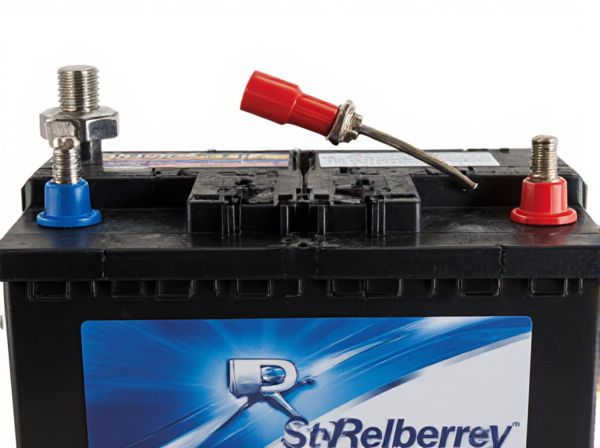
Photo illustration: Push-button Terminal vs Stud Terminal
Push-button terminals offer quick and tool-free wire connections, making them ideal for applications requiring frequent wiring changes or fast installation. Stud terminals provide a robust, secure connection suitable for handling high current and ensuring long-term reliability in heavy-duty electrical systems. Understanding your specific load and maintenance needs will help determine the best terminal type for your project.
Table of Comparison
| Feature | Push-button Terminal | Stud Terminal |
|---|---|---|
| Connection Type | Quick connect with push-button mechanism | Bolted connection using threaded stud |
| Installation Speed | Faster, tool-free installation | Slower, requires tools for tightening |
| Security | Moderate, prone to accidental release | High, secure and stable connection |
| Durability | Less durable under vibration | More durable in harsh conditions |
| Maintenance | Easy to disconnect and service | Requires tools for disconnection |
| Common Usage | Consumer vehicles, quick maintenance | Commercial vehicles, heavy-duty use |
Introduction to Push-Button and Stud Terminals
Push-button terminals provide a quick, tool-free connection method by simply pressing a button to insert or release the wire, ensuring secure and efficient wiring in electrical installations. Stud terminals use a threaded stud and nut to clamp the wire securely, offering a robust and durable connection ideal for high-current applications. Both terminal types enhance electrical connectivity but cater to different installation needs and environments.
Understanding Push-Button Terminals
Push-button terminals provide a quick and secure wiring solution by allowing users to insert a wire and lock it in place with a simple push mechanism, eliminating the need for screws or additional tools. Their design ensures efficient electrical connections and reduces installation time while maintaining high contact reliability for various applications. Compared to stud terminals, push-button terminals offer greater convenience and flexibility, particularly in control panels and automation systems where frequent wiring changes may be required.
Overview of Stud Terminals
Stud terminals provide a secure and reliable connection by using a threaded post where wires are fastened with nuts, often found in automotive batteries and heavy-duty electrical applications. They offer superior mechanical strength and excellent conductivity, making them ideal for high-current connections and minimizing voltage drops. Compared to push-button terminals, stud terminals require tools for installation and removal, ensuring a tight, vibration-resistant connection critical in industrial settings.
Key Differences Between Push-Button and Stud Terminals
Push-button terminals offer quick, tool-free wire connections through a spring-loaded mechanism, enhancing speed and ease of use in electrical installations. Stud terminals require securing wires under a screw or bolt, providing a more secure and vibration-resistant connection ideal for heavy-duty applications. The key differences lie in their connection methods, installation speed, and suitability for varying electrical loads and environments.
Installation Process: Push-Button vs Stud Terminal
Push-button terminals offer a streamlined installation process by allowing wires to be inserted and secured quickly through a simple press mechanism, eliminating the need for tools or additional components. Stud terminals require tightening a nut onto a threaded stud, ensuring a secure connection but involving more steps and tools during installation. The push-button design increases efficiency in high-volume wiring tasks, while stud terminals provide robust mechanical strength ideal for heavy-duty applications.
Electrical Performance Comparison
Push-button terminals offer quick and tool-free wire connections with reliable contact resistance typically below 5 milliohms, enhancing signal integrity especially in low-voltage circuits. Stud terminals, known for their robust mechanical strength and stable clamp force, maintain consistent conductivity under high current loads exceeding 100 amps. While push-button terminals excel in ease of use and moderate electrical performance, stud terminals provide superior durability and minimal voltage drop in demanding power applications.
Safety and Reliability Factors
Push-button terminals offer enhanced safety by minimizing the risk of loose connections through secure, tool-free wire insertion, which reduces electrical arcing and potential short circuits. Stud terminals provide robust reliability with strong mechanical fastening, ensuring stable connections in high-vibration environments, but require proper tightening tools to prevent safety hazards. Both terminal types prioritize electrical conductivity and prevent overheating when installed correctly, influencing overall system safety and longevity.
Maintenance and Troubleshooting
Push-button terminals simplify maintenance by allowing quick, tool-free wire insertion and removal, reducing downtime during troubleshooting. Stud terminals offer robust and secure connections suitable for high-current applications but require tools for disassembly, potentially prolonging maintenance tasks. Regular inspection of push-button terminals ensures contact integrity, while stud terminals benefit from torque checks to maintain reliable electrical connections.
Application Scenarios for Each Terminal Type
Push-button terminals are ideal for applications requiring frequent wiring changes or maintenance, such as control panels and prototyping environments, due to their easy and quick connection and disconnection capabilities. Stud terminals excel in high-current, vibration-prone environments like automotive and heavy machinery, providing durable and secure connections that withstand mechanical stress. Selecting between push-button and stud terminals depends on the need for operational flexibility versus robust, long-term electrical connections.
Choosing the Right Terminal for Your Needs
Choosing the right terminal depends on your application's specific requirements, including ease of installation, maintenance, and electrical load capacity. Push-button terminals offer quick, tool-free connections ideal for frequent wiring changes, while stud terminals provide robust, secure connections suitable for high-current applications and harsh environments. Evaluating factors such as current rating, mechanical stability, and accessibility ensures optimal performance and safety for your electrical system.
 caratoz.com
caratoz.com